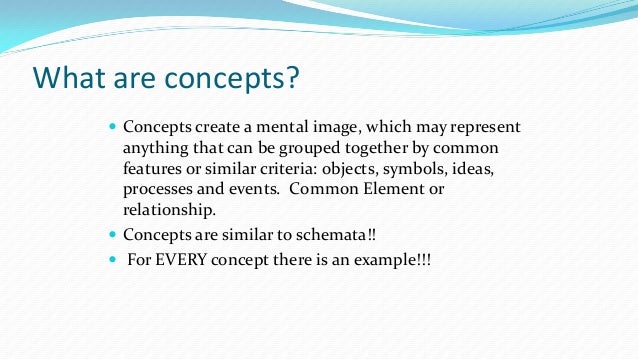Does Activate Schemata Mean
This article has an unclear citation style. The references used may be made clearer with a different or consistent style of,. (April 2012) In and, a schema (plural schemata or schemas) describes a pattern of thought or behavior that organizes categories of information and the relationships among them. It can also be described as a mental structure of preconceived ideas, a framework representing some aspect of the world, or a system of organizing and perceiving new information. Schemata influence attention and the absorption of new knowledge: people are more likely to notice things that fit into their schema, while re-interpreting contradictions to the schema as exceptions or distorting them to fit.
Schemata have a tendency to remain unchanged, even in the face of contradictory information. Schemata can help in understanding the world and the rapidly changing environment. People can organize new perceptions into schemata quickly as most situations do not require complex thought when using schema, since automatic thought is all that is required. People use schemata to organize current knowledge and provide a framework for future understanding.

An internal representation of the world; an organization of concepts and actions that can be revised by new information about the world. A schematic or preliminary plan. Familiarity information: SCHEMA used as a noun is rare. This post was written by Laura Greenwood. Why should you activate your ESL students’ background schema when teaching English as a foreign language? Activating schema is a concept that revolves around accessing the individual learner’s prior knowledge of the information being learned. If an internet search is made on activating schema, the first page displays various articles on schema and the instruction of reading.

Examples of schemata include, stereotypes, and. In of development, children construct a series of schemata, based on the interactions they experience, to help them understand the world. Contents.
History Before psychology separated from philosophy, the term 'schema' was prominently discussed in philosophy. Early developments of the idea in psychology emerged with the and: the term 'schema' was introduced by Piaget in 1923. The concept was popularized in psychology and education through the work of the British psychologist, who drew on the term used by neurologist. It was expanded into schema theory by educational psychologist Richard C. Since then, other terms have been used to describe schema such as 'frame', 'scene' and 'script'. Schematic processing Through the use of schemata, a technique to encode and retrieve memories, the majority of typical situations do not require much strenuous processing. People can quickly organize new perceptions into schemata and act without effort.
However, schemata can influence and hamper the uptake of new information , such as when existing, giving rise to limited or discourses and expectations , lead an individual to 'see' or 'remember' something that has not happened because it is more believable in terms of his/her schema. For example, if a well-dressed businessman draws a knife on a vagrant, the schemata of onlookers may (and often do) lead them to 'remember' the vagrant pulling the knife.
Such distortion of memory has been demonstrated. (See below.) Schemata are interrelated and multiple conflicting schemata can be applied to the same information. Schemata are generally thought to have a level of activation, which can spread among related schemata. Which schema is selected can depend on factors such as current activation, accessibility, and emotion. Accessibility is how easily a schema comes to mind, and is determined by personal experience and expertise. This can be used as a cognitive shortcut; it allows the.
With priming, a brief imperceptible stimulus temporarily provides enough activation to a schema so that it is used for subsequent ambiguous information. Although this may suggest the possibility of, the effect of priming is so fleeting that it is difficult to detect outside laboratory conditions. Furthermore, the —which requires consciousness of the stimuli—is far more effective than priming.

Background research The original concept of schemata is linked with that of reconstructive memory as proposed and demonstrated in a series of experiments by Bartlett. By presenting participants with information that was unfamiliar to their cultural backgrounds and expectations and then monitoring how they recalled these different items of information (stories, etc.), Bartlett was able to establish that individuals' existing schemata and stereotypes influence not only how they interpret 'schema-foreign' new information but also how they recall the information over time. One of his most famous investigations involved asking participants to read a Native American folk tale, 'The War of the Ghosts', and recall it several times up to a year later. All the participants transformed the details of the story in such a way that it reflected their cultural norms and expectations, i.e.
In line with their schemata. Main article: Schema therapy was founded by, and represents a development of (CBT) specifically for treating. Early maladaptive schemata are described by Young as broad and pervasive themes or patterns made up of memories, feelings, sensations, and thoughts regarding oneself and one's relationships with others. They are considered to develop during childhood or adolescence, and to be dysfunctional in that they lead to self-defeating behavior. Examples include schemata of abandonment/instability, mistrust/abuse, emotional deprivation, and defectiveness/shame. Schema therapy blends CBT with elements of, and therapies in order to treat the characterological difficulties which both constitute personality disorders and which underlie many of the chronic depressive or anxiety-involving symptoms which present in the clinic. Young said that CBT may be an effective treatment for presenting symptoms, but without the conceptual or clinical resources for tackling the underlying structures (maladaptive schemata) which consistently organize the patient's experience, the patient is likely to lapse back into unhelpful modes of relating to others and attempting to meet their needs.
Reading
Young focused on pulling from different therapies equally when developing schema therapy. The difference between cognitive behavioral therapy and schema therapy is the latter 'emphasizes lifelong patterns, affective change techniques, and the therapeutic relationship, with special emphasis on '. He recommended this therapy would be ideal for clients with difficult and chronic psychological disorders. Some examples would be, personality disorders and criminal offenders.
Activate Schemata
He has also had success with this therapy in relation to depression and substance abuse. See also.
References.